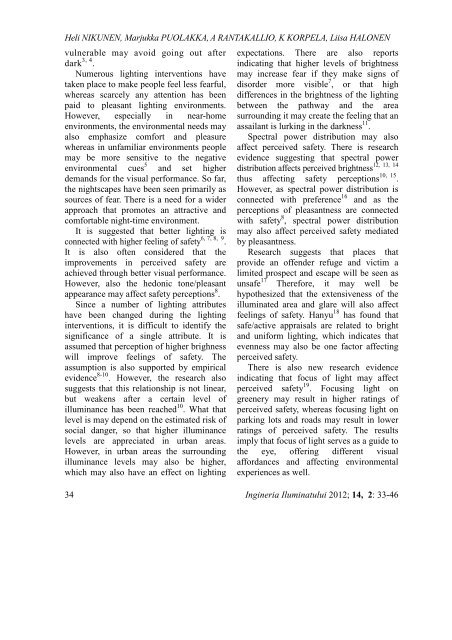Untitled - Journal of Lighting Engineering
Untitled - Journal of Lighting Engineering
Untitled - Journal of Lighting Engineering
You also want an ePaper? Increase the reach of your titles
YUMPU automatically turns print PDFs into web optimized ePapers that Google loves.
Heli NIKUNEN, Marjukka PUOLAKKA, A RANTAKALLIO, K KORPELA, Liisa HALONEN<br />
vulnerable may avoid going out after<br />
dark 3, 4 .<br />
Numerous lighting interventions have<br />
taken place to make people feel less fearful,<br />
whereas scarcely any attention has been<br />
paid to pleasant lighting environments.<br />
However, especially in near-home<br />
environments, the environmental needs may<br />
also emphasize comfort and pleasure<br />
whereas in unfamiliar environments people<br />
may be more sensitive to the negative<br />
environmental cues 5 and set higher<br />
demands for the visual performance. So far,<br />
the nightscapes have been seen primarily as<br />
sources <strong>of</strong> fear. There is a need for a wider<br />
approach that promotes an attractive and<br />
comfortable night-time environment.<br />
It is suggested that better lighting is<br />
connected with higher feeling <strong>of</strong> safety 6, 7, 8,u9 .<br />
It is also <strong>of</strong>ten considered that the<br />
improvements in perceived safety are<br />
achieved through better visual performance.<br />
However, also the hedonic tone/pleasant<br />
appearance may affect safety perceptions 8 .<br />
Since a number <strong>of</strong> lighting attributes<br />
have been changed during the lighting<br />
interventions, it is difficult to identify the<br />
significance <strong>of</strong> a single attribute. It is<br />
assumed that perception <strong>of</strong> higher brighness<br />
will improve feelings <strong>of</strong> safety. The<br />
assumption is also supported by empirical<br />
evidence 8-10 . However, the research also<br />
suggests that this relationship is not linear,<br />
but weakens after a certain level <strong>of</strong><br />
illuminance has been reached 10 . What that<br />
level is may depend on the estimated risk <strong>of</strong><br />
social danger, so that higher illuminance<br />
levels are appreciated in urban areas.<br />
However, in urban areas the surrounding<br />
illuminance levels may also be higher,<br />
which may also have an effect on lighting<br />
34<br />
expectations. There are also reports<br />
indicating that higher levels <strong>of</strong> brightness<br />
may increase fear if they make signs <strong>of</strong><br />
disorder more visible 7 , or that high<br />
differences in the brightness <strong>of</strong> the lighting<br />
between the pathway and the area<br />
surrounding it may create the feeling that an<br />
assailant is lurking in the darkness 11 .<br />
Spectral power distribution may also<br />
affect perceived safety. There is research<br />
evidence suggesting that spectral power<br />
distribution affects perceived brightness 12,u13,u14<br />
thus affecting safety perceptions 10,u15 .<br />
However, as spectral power distribution is<br />
connected with preference 16 and as the<br />
perceptions <strong>of</strong> pleasantness are connected<br />
with safety 8 , spectral power distribution<br />
may also affect perceived safety mediated<br />
by pleasantness.<br />
Research suggests that places that<br />
provide an <strong>of</strong>fender refuge and victim a<br />
limited prospect and escape will be seen as<br />
unsafe 17 Therefore, it may well be<br />
hypothesized that the extensiveness <strong>of</strong> the<br />
illuminated area and glare will also affect<br />
feelings <strong>of</strong> safety. Hanyu 18 has found that<br />
safe/active appraisals are related to bright<br />
and uniform lighting, which indicates that<br />
evenness may also be one factor affecting<br />
perceived safety.<br />
There is also new research evidence<br />
indicating that focus <strong>of</strong> light may affect<br />
perceived safety 19 . Focusing light on<br />
greenery may result in higher ratings <strong>of</strong><br />
perceived safety, whereas focusing light on<br />
parking lots and roads may result in lower<br />
ratings <strong>of</strong> perceived safety. The results<br />
imply that focus <strong>of</strong> light serves as a guide to<br />
the eye, <strong>of</strong>fering different visual<br />
affordances and affecting environmental<br />
experiences as well.<br />
Ingineria Iluminatului 2012; 14, 2: 33-46
















